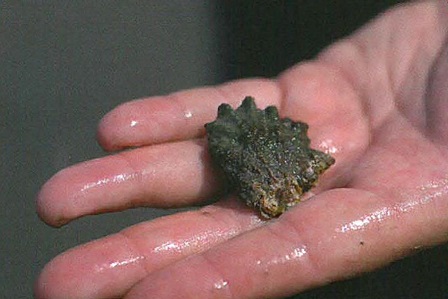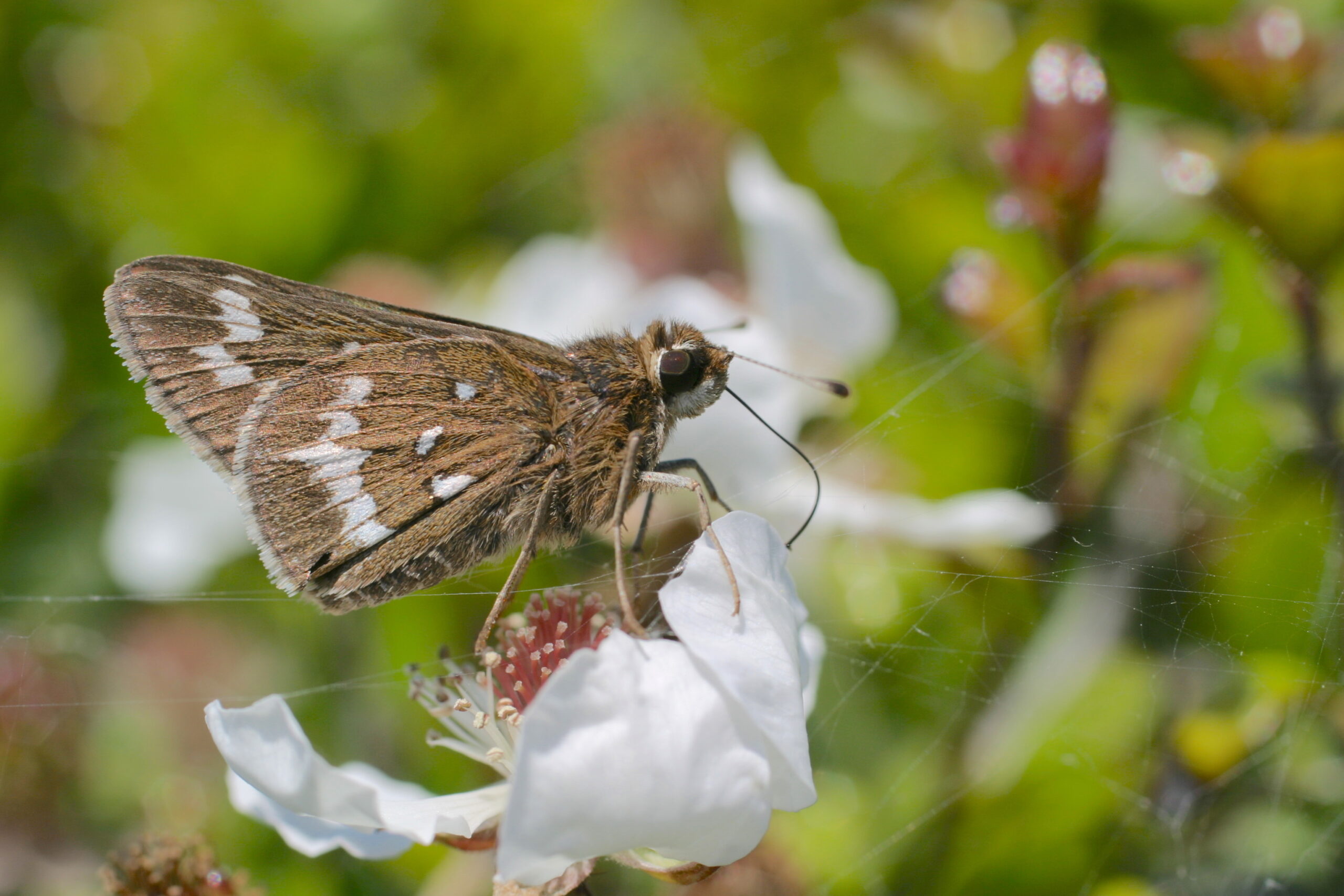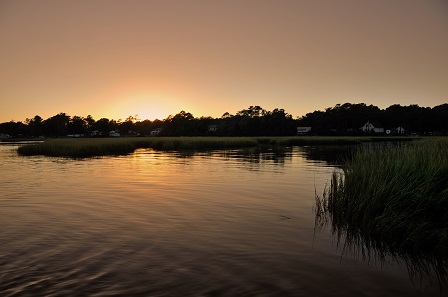Drifting Along: Sea Grant Scientists Study Oyster Larvae

It is a calm day on the Pamlico Sound. Standing on a boat bow, Amy Haase focuses her binoculars on a bright orange and white floating object.
‘The drifter is up ahead on the starboard side,” says Haase, a North Carolina State University graduate student.
Two U.S. Coast Guard Auxiliary members prepare to retrieve a drifter with a ball and drogue, or neutrally buoyant float suspended below the water surface. One man drops a net into the water and then scoops up a drift buoy, known as a drifter. Then both men lift the 40-pound drifter onto the deck.
Haase walks over, disconnects the drogue and folds it like an umbrella.
“Excellent job,” yells Haase. “Now, we have to find four more drifters.”
As the captain increases speed, Haase records the latitude and longitude of the drifter that had moved with the currents for the past 24 hours.
Every 10 minutes, the buoy records its position and contacts a central computer via a satellite cell phone. The recorded locations measure currents, while an attached instrument measures water temperature.
This data is part of a North Carolina Sea Grant study on oyster larval transport from sanctuaries managed by the N.C. Division of Marine Fisheries (DMF). NC State scientists Cynthia Cudaback, Dave Eggleston and Lian Xie are conducting the study, along with their graduate students.
The U.S. Coast Guard Auxiliary and other volunteers help to retrieve the buoys. The work is a good learning experience.
“I like being out on the water,” says Chuck Foreman, U.S. Coast Guard Auxiliary coxswain. “It is good training using GPS. This helps us with search and rescue.”
NATIVE OYSTER
The Sea Grant study focuses on the American oyster (Crassostrea virginica), which faces the often harsh and constantly changing conditions in North Carolina’s rivers and sounds.
Restoration and conservation of oyster reefs in North Carolina and other states have increased in recent years. Much of this push comes from a better understanding of how oysters filter polluted waters and how reefs provide habitat for many other species.
“A single oyster can filter almost six liters of water each hour,” explains Eggleston, director of NC State’s Center for Marine Science & Technology in Morehead City.
This function helps remove pollutants in the sounds, bays and other coastal waters.
To restore the oyster population in the state’s estuaries, DMF builds reefs on sanctuary sites that have a history of viable oyster production. Natural oyster shell or limestone concrete are the base of reefs. Harvesting oysters and the use of bottom-disturbing gear are prohibited in the sanctuaries to allow a broodstock of oysters to develop.
DMF manages nine oyster sanctuaries in estuarine waters from Dare to Carteret counties, and two more are in the planning stages. The N.C. Coastal Federation and The Nature Conservancy also are restoring reefs throughout the state.
“We are considering building a new sanctuary on the north side of the Neuse River,” explains Craig Hardy, chief of the DMF Resource Enhancement Section. “We now have a sanctuary on the south side of the river.”
And DMF also oversees the Under Dock Oyster Culture Program that allows residents to grow oysters under their coastal docks or piers. Qualified permit holders can attach up to 90 square feet of oyster cultivation containers to a dock or pier that they own.
LARVAE STUDY
Each oyster produces millions of eggs annually that are carried by currents and tides to surrounding areas. By developing and protecting a broodstock, the availability of native oyster in adjacent areas increases.
Oysters spawn from May to September, with a peak in mid- to late-June. Larvae then disperse to reefs.
Last summer, Sea Grant-supported scientists began tracking water movement from key broodstock sanctuaries in the Croatan and Pamlico sounds.
From preliminary data, scientists have determined that estuarine currents roughly follow the direction of the wind, which is likeh the same pattern for oyster larvae, according to Haase.
Winds in the Albemarle-Pamlico Estuarine System are generally southwestwardly in the summer and fall when larvae are moving through the water column, according to Cudaback.
“We expect to see connectivity between the Crab Hole sanctuary south of Roanoke Island and five other sanctuaries in the main part of the Pamlico Sound,” she adds. “However, the West Bay sanctuary in the Neuse River may be more isolated from the rest of the sound.”
The estuarine system comprises about 3,000 square miles of brackish water, with a 30,000-square-mile drainage system.
“Although oysters are both commercially and economically significant in this region and several oyster studies have been conducted in other parts of North Carolina, this is the first time that oyster larval transport has been studied in the Pamlico Sound,” says Cudaback.
Tides are relatively weak in the Pamlico Sound, she adds.
The North Carolina system is quite different from the Chesapeake Bay, where more oyster larval transport studies have been conducted. Researchers have found that restoration efforts in the Chesapeake Bay have been successful in areas where circulation retains larvae near the reefs, and low salinity reduces the incidence of certain diseases.
Cudaback says that NC State researchers will compare data with Chesapeake Bay studies, as well as results from a previous Sea Grant project on blue crab larval transport in the Pamlico Sound.
To study how depth in the water column and salinity affect the transport of oyster larvae, scientists deploy Acoustic Doppler Current Profilers (ADCP) on the sound bottom. The profilers record currents at all depths, every five minutes, and work continuously for up to three months.
To get a complete understanding of the circulation, currents measured by the ADCP will be compared with currents measured by the drift buoy, Cudaback adds.
“This study is unusual in that it teams biologists with geophysicists to attack the problem from more than one angle,” says North Carolina Sea Grant Associate Director Steve Rebach.
This summer, Sea Grant researchers will deploy drift buoys again in the Pamlico Sound and draw upon the Coast Guard auxiliary for volunteers.
“Understanding the flow patterns of the estuary will provide our managers with information to build new sanctuaries and supply larvae to areas that need enhancement,” Hardy says. “If we know where the larvae from the individual sanctuaries will be when they settle, we can deploy materials in those areas, providing substrate to increase their settlement.”
Also, data about the estuary’s flow patterns will help DMF managers decide where to provide larvae when building new sanctuaries.
“The Sea Grant study provides vital information that ties together two important oyster restoration projects, maximizing the success of both,” Hardy adds.
FRG STUDY
With a North Carolina Fishery Resource Grant (FRG), Eggleston works with Outer Banks commercial fisherman Eugene Ballance, who has updated historical mapping of oyster beds in the Pamlico Sound.
The scientists now are mapping the spatial extent and topography of six oyster sanctuaries in the Pamlico Sound. The FRG program, funded by the N.C. General Assembly, is administered by North Carolina Sea Grant.
To measure the variation of oyster larval settlements, researchers are using shell strings suspended off docks throughout Pamlico Sound and checked weekly by high school students.
“Variation in oyster larvae settlement in the Pamlico Sound during the summer and fall larval period will be compared with mathematical model predictions to see how reliable models are in telling us where larvae settle,” Eggleston says. “And the drifters will give us information on where the larvae come from.”
In 2006, 13 high school students from Manteo, Oriental, Englehart, Bayboro, Hatteras, Ocracoke and Cedar Island were involved in a range of research activities, including: collecting the shells, deploying new oyster larvae, and measuring the temperature, salinity and water for chlorophyll analysis.
“This is a great educational opportunity for high school students to be exposed to science,” says NC State graduate student Brandon Puckett.
Preliminary results show that settlement is low in the southwestern Pamlico Sound, Eggleston says. “This is the same pattern that was found in the Pamlico Sound when we measured blue crab settlement over a 10-year period.”
The team also found that oyster settlement peaks early in the summer near Ocracoke and Hatteras. Researchers will analyze the relative magnitude of oyster settlement in relation to wind direction and speed, he adds.
Another part of the study examines the fate of oyster larvae following settlement.
Eggleston and Ballance are monitoring oysters over time to determine at which sanctuaries oysters grow the fastest and survive the longest.
DMF will use the data to rank the best locations for broodstock sanctuaries, according to Eggleston.
“As successive generations of oyster settle and grow, reefs develop many nooks and
crannies that provide a wealth of microhabitats for many different species of animals,” says Sara Mirabilio, North Carolina Sea Grant fisheries specialist.
A study in 1961 by Harry W. Wells of Duke University found that more than 303 different species utilized oyster reefs as a habitat in North Carolina, she adds.
VALUABLE SPECIES
Since before recorded history, the oyster has been an important food source in coastal North Carolina. When the Europeans first arrived, they were amazed at the number of oysters they found.
The Carolina oyster industry peaked in the 1880s when companies from Baltimore built large canneries in coastal towns. At the same time, commercial fishers began using oyster dredges.
Despite later attempts to restrict dredging, most of the damage to oyster beds already had occurred by 1910, when the oyster stock began to decline.
“Oysters landings are now about 1 percent of a century ago,” Cudaback says. “This collapse has had devastating economic and ecological impacts.”
In 2005, more than 377,000 pounds of oyster meat was harvested in the state at a value of more than $1.6 million, compared to 545,000 pounds in 1985 valued at more than $1 million, according to DMF.
In North Carolina, oysters are found from the extreme southeastern end of the Albemarle near the northern end of Roanoke Island southward through the Croatan, Roanoke and Pamlico sounds to the estuaries of the south of the state near the South Carolina border.
However, in the last three to four years, the oyster population has been on an upward trend from the historical low harvesting in the mid-1990s, according to Hardy.
Hardy attributes this increase to the decline of Dermo or Perkinus marinus, a protozoan parasite that is easily transmitted from oyster to oyster. “There has been a return to more normal climate and salinity levels,” he adds. “In the mid-90s, mild winters and increased salinity caused the incidence of Dermo to rise.”
Oysters are harvested from October to March with tongs, rakes or by hand in intertidal areas with shallow water along coastal North Carolina. Commercial fishers also use dredges in parts of the Pamlico Sound.
In North Carolina, oysters are found from the extreme southeastern end of the Albemarle Sound near the northern end of Roanoke Island southward through the Croatan, Roanoke and Pamlico sounds to the estuaries of the southern part of the state near the South Carolina border.
OYSTER RESTORATION RESEARCH
For several years, North Carolina Sea Grant researchers Martin Posey and Troy Alphin have been conducting cutting-edge research on reef design to develop best practices for restoring oysters for both the fishing industry and ecosystem functions, including water quality and fish habitat.
The University of North Carolina Wilmington scientists found that high complexity reefs with numerous crevices were used more as a habitat for a variety of fish, shrimp and crabs, including blue crabs, than reefs with less structure. These reefs also provided habitat for many small invertebrates that are a food source for important fishery species.
In addition, the reef edge affects local currents, the organic material and the amount of nutrients inside the reef and in adjacent sandflats.
Posey and Alphin have used the research results to help the N.C. Coastal Federation on the site selection, reef design and sizing of oyster reefs on a number of coastal projects.
DMF also has used the data for cultch planting of hard materials like shells and limestone on man-made sanctuaries.
In a new Sea Grant study, Posey and Alphin and UNCW graduate student Ted Wilgis are analyzing the success of five oyster reef restoration projects on the central and southeastern coast.
“Our objective is to test proposed standardized sampling methods by assessing the use of restoration projects as habitats and for improving water quality,” says Posey.
The work also examines how variations in shell thickness affect reef creation, the effect of landscape on restoration success, as well as the effect of seeding on newly created shell reefs with live oysters being used to jumpstart development.
The study involves assessment of oyster density and size, as well as organisms living within the reef system — fish, shrimp and crabs that use the reef as a habitat and place to feed. The project — which grew out of a National Sea Grant effort — involves a collaborative effort among North Carolina and South Carolina researchers.
“Preliminary results show that all restoration efforts are not equally successful,” Posey says.
Some artificial reefs appear to have developed communities similar to natural areas in the same vicinity within only three years of establishment, he adds.
“However, certain reefs still do not have a well-developed reef community and have low densities of oysters compared to adjacent areas,” Posey says. “The key to restoration is understanding why some efforts are more successful than others.”
The information will be useful to North Carolina resource managers, as well as others who are interested in reviewing the effectiveness of oyster restoration projects, Posey explains.
“Oyster restoration is a priority with North Carolina, as well as many coastal states from the mid-Atlantic to the Gulf of Mexico.”
To find out more about DMF sanctuaries, visit the Web: www.ncfisheries.net and click on “Shellfish & Crustaceans” and then “Shellfish Sanctuaries.”
This article was published in the Spring 2007 issue of Coastwatch.
For contact information and reprint requests, visit ncseagrant.ncsu.edu/coastwatch/contact/.
- Categories:


